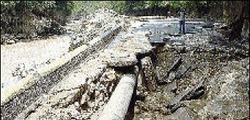
A section of the Bog Walk gorge which was severely damaged during the passage of Tropical Storm Gustav in 2004. - File
If things go as planned, before the end of the 2009 Hurricane Season, the Office of Disaster Preparedness and Emergency Management (ODPEM) will be installing electronic warning signals along the roadway leading to the Bog Walk gorge in St Catherine.
The system would serve as a real-time warning mechanism for motorists using the problematic Flat Bridge, which is often made impassable by flood waters from the Rio Cobre.
In 2007, more than 50 persons were trapped in the treacherous ravine for hours after the river overflowed on to the roadway. The persons, including an elderly woman, were eventually rescued by members of the Jamaica Defence Force.
Last year, the situation was similar, as rains associated with Tropical Storm Gustav flooded the gorge, trapping a busload of people and ripping apart the roadway, forcing authorities to close the route for several days.
Director general of the ODPEM, Ronald Jackson, said the aim was to reduce or eradicate such dangerous and life-threatening occurrences. "What we're doing is trying to avert any of those harsh experiences by putting in this system," he said.
The new electronic system, which is expected to cost millions, would work along with the telemetric and manual staff gauges that are already in place at the bridge.
"The telemetric gauge was implemented in the 1990s, however, a lot of the parts have become obsolete and are now being enhanced," Jackson said. "We're almost complete with bringing that system back up."
Two stages
Jackson explained that the system would work in two stages. The telemetric warning system sends an electronic message from the gauge, which is in the gorge, back to a terminal at the ODPEM, the Water Resources Authority and the Meteorological Services.
The other part of the system is a manual colour-coded gauge, which is on the Rio Cobre itself and graduated in feet. "Once it gets to a certain level, between eight and nine feet, we launch the alert, because once it gets to 10 feet, it starts to flood," Jackson said.
He continued: "What we have been doing over the last couple of years is that we have someone who lives close to that gauge and once it starts to rain, they periodically read the levels and report back to Water Resources and ourselves, at which point in time we alert media sources to announce it for us."
Jackson, however, pointed out that despite this, in addition to asking the police to close the gorge, there were still instances of people getting trapped in the ravine because they might have missed the media alerts.
He said the aim, therefore, is to improve the system by putting in electronic message boards at strategic locations to alert motorists of the danger before they enter the gorge, instructing them to use the alternative routes.
Sirens at strategic locations
"We're going to also put with that some sirens at strategic locations for those who would have probably passed the signs and are heading into the gorge. Those sirens would flash to let them know there is danger," he said.
In addition, Jackson said a gate would be built so that the gorge could be physically closed, as well as cameras placed at strategic points so that the authorities would be able to monitor the situation in the gorge.
The director general said the agency had managed to obtain all the indicative costs on the new system except the cost to build the gate. Once that is received the project would be put to tender, he said.
athaliah.reynolds@gleanerjm.com